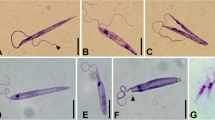Summary
Flagellar attachment to the cuticle lined fore and hindgut ofAnopheles gambiae has been studied. At an attachment site, the flagellar membrane follows the contour of the surface to which it is apposed. In the colon where there is little folding of the gut the flagellum is truncate but in regions where the cuticular lining is highly folded the tip of the flagellum is more variable in shape. Numerous filaments lying beneath the adhering membrane make attachment sites easy to recognise. Although haptomonads lying close to the gut possess a short flagellum, those cells which in heavy infections are separated from the gut wall by severalμm develop a much longer organelle in order to reach the cuticular lining.
The induction of flagellar detachment by the addition of distilled water begins with the appearance of membrane invaginations at the adhesion site. Some of these invaginations, which appear to take cuticular material with them, develop into vesicles. It appears that this process progressively reduces the area of adhesion so that when flagellar activity begins, detachment is easily effected.
Similar content being viewed by others
References
Brooker, B. E., 1970: Desmosomes and hemidesmosomes in the flagellateCrithidia fasciculata. Z. Zellforsch.105, 155–166.
—, 1971: Flagellar adhesion ofCrithidia fasciculata to millipore filters. Protoplasma72, 19–25.
Molyneux, D. H., 1969: The fine-structure of the epimastigote forms ofTrypanosoma lewisi in the rectum of the fleaNosopsyllus fasciatus. Parasitology59, 55–66.
Noguchi, H., andE. B. Tilden, 1926: Comparative studies of herpetomonads and leishmanias. I. Cultivation of herpetomonads from insects and plants. J. exp. Med.44, 307–325.
Perkins, D. L., andT. L. Jahn, 1970: Amoeboflagellate transformations and the Gibbs-Donnan ratio. J. Protozool.17, 168–172.
Ramsay, J. A., 1958: Excretion by the Malpighian tubules of the stick insect,Dixippus morosus (Orthoptera, Phasmidae): amino acids, sugars, and urea. J. exp. Biol.35, 871–891.
Robertson, M., 1911: Transmission of flagellates living in the blood of certain freshwater fishes. Phil. Trans. (B)202, 29–50.
Ross, R., 1906: Notes on the parasites of mosquitoes found in India between 1895 and 1899. J. Hyg.6, 101–109.
Vickerman, K., 1966: Electron microscopy of tsetse salivary gland stages in the life-cycle ofTrypanosoma rhodesiense. Trans. R. Soc. trop. Med. Hyg.60, 8.
Wallace, F. G., 1966: The trypanosomatid parasites of insects and arachnids. Exp. Parasit.18, 124–193.
—, andA. Johnson, 1961: The infectivity of old cultured strains of mosquito flagellates. J. Insect Path.3, 75–80.
Author information
Authors and Affiliations
Rights and permissions
About this article
Cite this article
Brooker, B.E. Flagellar attachment and detachment ofCrithidia fasciculata to the gut wall ofAnopheles gambiae . Protoplasma 73, 191–202 (1971). https://doi.org/10.1007/BF01275594
Received:
Revised:
Issue Date:
DOI: https://doi.org/10.1007/BF01275594




